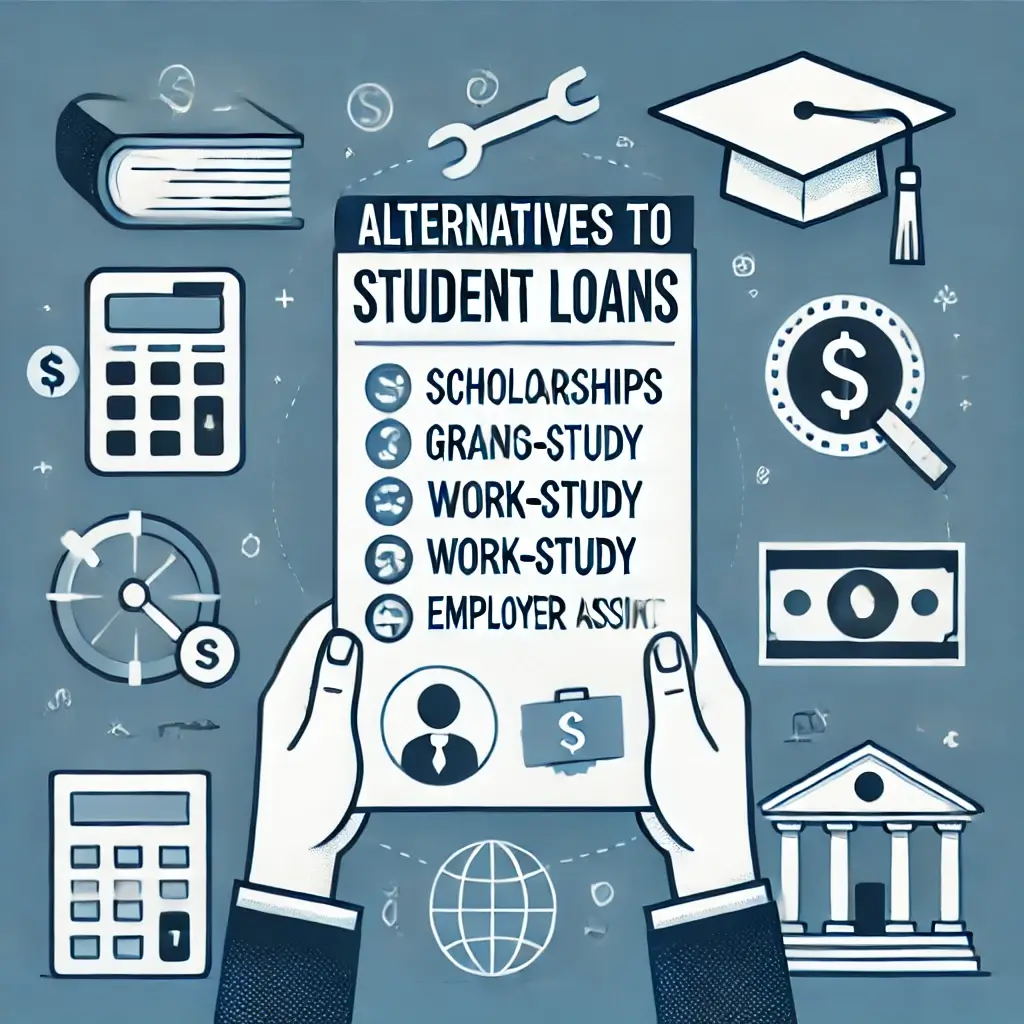While student loans are a common way to finance higher education, they often come with long-term debt and high interest rates. Fortunately, several Alternatives to Student Loans can help you cover educational expenses without taking on significant debt. This guide will explore the best options for funding your education without resorting to loans.
1. Scholarships: Free Money for Your Education
One of the best Alternatives to Student Loans is scholarships. Scholarships provide students with free money for education, often based on merit, financial need, or specific criteria such as field of study or community service. Unlike loans, scholarships do not need to be repaid.
1.1 Types of Scholarships
Scholarships come in many forms, offering various opportunities to reduce or eliminate the need for student loans:
- Merit-Based Scholarships: Awarded based on academic achievement, athletic performance, or other talents.
- Need-Based Scholarships: Offered to students with demonstrated financial need.
- Specialized Scholarships are available for students in specific fields of study, such as STEM, or for underrepresented groups.
1.2 Where to Find Scholarships
- School Financial Aid Offices: Many universities offer incoming and current students scholarships.
- Online Scholarship Databases: Websites like Fastweb, Scholarship, and College Board offer extensive scholarship listings.
- Community Organizations: Local clubs, businesses, and non-profits often provide scholarships to students in their area.
Scholarships are a highly effective way to reduce educational costs, making them one of the top Alternatives to Student Loans.
2. Grants: Financial Aid You Don’t Repay
Grants are another excellent option for students looking for Alternatives to Student Loans. Like scholarships, grants do not require repayment. They are typically based on financial need and are offered by the federal government, state agencies, and schools.
2.1 Types of Grants
- Federal Pell Grants: Available to undergraduate students with significant financial need.
- Federal Supplemental Educational Opportunity Grants (FSEOG): Provided to students with exceptional financial need, on top of Pell Grants.
- State Grants: Many states offer grant programs to residents attending in-state schools.
2.2 How to Apply for Grants
To be considered for most grants, students must fill out the Free Application for Federal Student Aid (FAFSA). The FAFSA determines a student’s eligibility for federal and state grants, as well as other forms of financial aid.
Grants are a crucial resource for students who qualify, providing substantial assistance without the burden of repayment.
3. Work-Study Programs: Earn Money While You Learn
Work-study programs allow students to work part-time while enrolled in school, providing a reliable income to help cover education costs. These programs are a great alternative to loans because they reduce the amount of money you need to borrow while offering valuable work experience.
3.1 Federal Work-Study Program
The Federal Work-Study Program provides part-time employment to students with financial needs, allowing them to earn money to pay for school-related expenses. Jobs are often located on campus, making it easy for students to balance work and studies.
3.2 Benefits of Work-Study
- No Need to Repay: Unlike loans, you don’t have to pay back work-study earnings.
- Flexibility: Work-study jobs are typically designed to accommodate a student’s academic schedule.
- Experience: Many work-study positions are related to a student’s field of study, providing valuable career experience.
Work-study programs provide an immediate way to earn money for education, making them one of the most practical Alternatives to Student Loans.
4. Employer Tuition Assistance Programs
Many employers offer tuition assistance programs as part of their benefits packages, making it easier for employees to further their education without taking out loans. These programs often reimburse employees for tuition, fees, and other educational expenses.
4.1 How Employer Tuition Assistance Works
Employers typically cover a portion of the cost of tuition and may require the employee to pursue a degree related to their job. Some employers offer full tuition reimbursement, while others provide a set amount per year.
4.2 Companies Offering Tuition Assistance
- Amazon: Covers up to 100% of tuition for certain degree programs.
- Starbucks: Provides full tuition coverage for employees pursuing a bachelor’s degree through Arizona State University.
- Walmart: Offers tuition and textbook coverage for its employees.
Employer tuition assistance is a valuable resource for working students looking for Alternatives to Student Loans, as it offers a direct way to offset education costs.

5. Crowdfunding and Sponsorships
Crowdfunding has emerged as a modern way to raise money for education without taking on debt. Platforms like GoFundMe and Kickstarter allow students to share their educational goals and raise money from friends, family, and even strangers.
5.1 How Crowdfunding for Education Works
Students create an online campaign detailing their educational needs and goals. Campaigns are shared via social media, email, and other platforms to reach potential donors. Some students can raise significant amounts of money, reducing or eliminating the need for student loans.
5.2 Educational Sponsorships
Some organizations and private sponsors offer educational sponsorships, where they cover a portion of a student’s tuition in exchange for meeting certain academic or community service requirements.
Crowdfunding and sponsorships are creative Alternatives to Student Loans that can provide significant financial support with no repayment obligations.
6. Apprenticeships and Paid Internships
For students seeking hands-on experience in their field of study, apprenticeships and paid internships are excellent Alternatives to Student Loans. These opportunities allow students to earn while they learn, covering education costs through work experience.
6.1 Benefits of Apprenticeships
Apprenticeships combine classroom learning with on-the-job training. Students earn a salary while gaining valuable industry experience, which can often lead to full-time employment after graduation.
6.2 Paid Internships
Paid internships are similar to apprenticeships but are typically shorter-term. Many companies offer paid internships to students in exchange for part-time work. These positions often lead to job offers after graduation.
Apprenticeships and paid internships provide income while building your resume, making them highly effective Alternatives to Student Loans.
7. Tuition-Free and Low-Cost Colleges
Some schools, both in the U.S. and abroad, offer tuition-free or low-cost education. These schools are excellent Alternatives to Student Loans because they minimize or eliminate the need to borrow money for college.
7.1 Tuition-Free Colleges in the U.S.
- Berea College (Kentucky): Offers a tuition-free education to students who demonstrate financial need.
- College of the Ozarks (Missouri): Provides a tuition-free education in exchange for campus work.
7.2 Low-Cost International Universities
Several countries offer low-cost or tuition-free education to international students, including Germany, Norway, and Finland. Studying abroad in these countries can significantly reduce the cost of higher education.
Tuition-free and low-cost colleges offer a debt-free path to a college degree, making them one of the most attractive Alternatives to Student Loans.
Conclusion
Many Alternatives to Student Loans can help you fund your education without incurring long-term debt. Scholarships, grants, work-study programs, employer tuition assistance, crowdfunding, apprenticeships, and tuition-free schools all offer ways to cover educational expenses. By exploring these options, you can reduce your reliance on student loans and achieve your educational goals with greater financial freedom.
